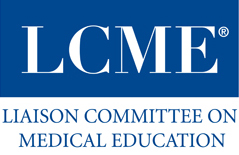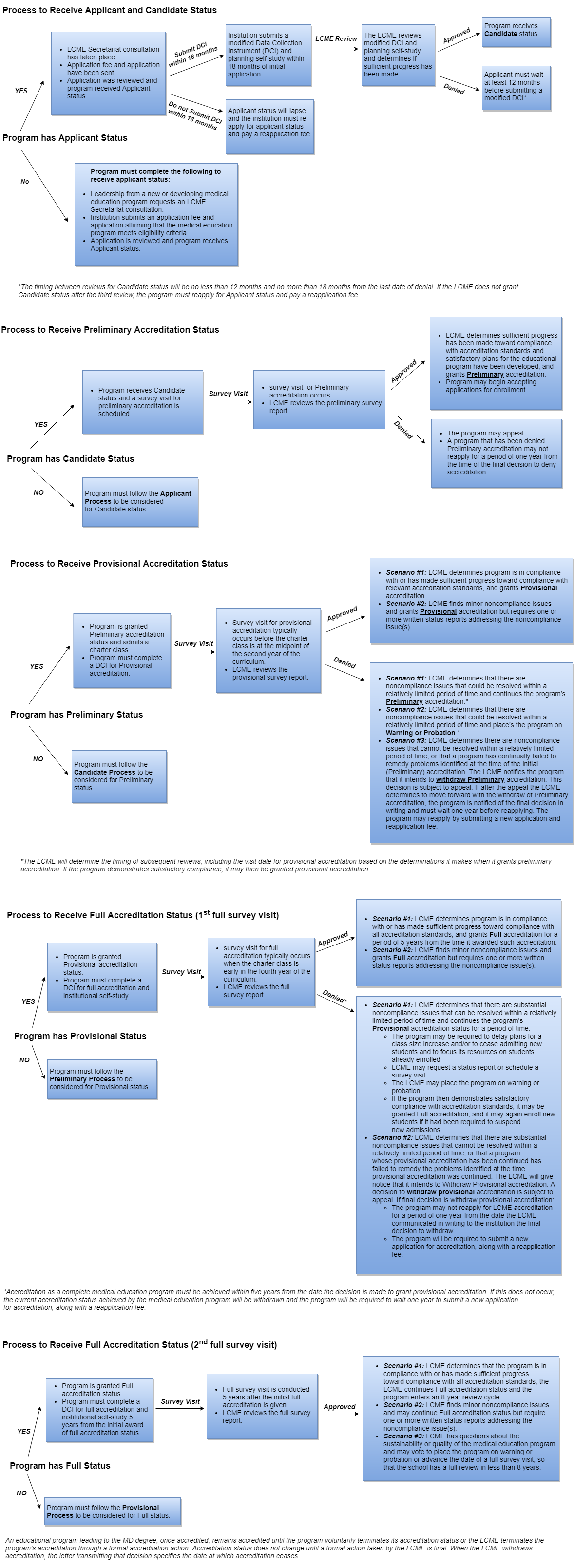Accreditation Process Overview
Possible LCME Actions
Based on evidence, when considering the accreditation status of a medical education program leading to the MD degree, the LCME may take any of the following actions at any time:
- Grant an accreditation status (accredited; accredited, preliminary status; accredited, provisional status)
- Continue an accreditation status, with or without specifying the term of accreditation
- Continue accreditation, but place the program on warning
- Continue accreditation, but place the program on probation
- Deny accreditation
- Withdraw accreditation
The LCME may also require one or more follow-up activities (limited survey visits, consultations, completion of an action plan, and/or status reports) if it determines that the program is not in compliance with all accreditation standards, has unsatisfactory performance in one or more elements, or if the LCME has identified areas that require monitoring where the final outcome could result in noncompliance with one or more accreditation standards or unsatisfactory performance in one or more elements.
Process for Obtaining LCME Accreditation
The diagrams below describe the process that a new medical education program follows to achieve full accreditation status. It includes possible outcomes for each step depending on LCME determinations.
Prior to receiving preliminary accreditation, new and developing medical education programs MAY NOT:
- recruit or advertise for students
- solicit or collect application fees or applicant information
- initiate a process for reviewing admissions applications
- schedule interviews for potential matriculants
- issue letters of admission
For more details about LCME policies, refer to the LCME Rules of Procedure. Questions about any step in this process should be directed to the LCME Co-Secretaries.
Maintaining LCME Accreditation
After full accreditation status has been granted by the LCME, there are activities that medical education programs must perform to maintain their accredited status. For more details, refer to the LCME Rules of Procedure. Direct questions about this information to the LCME Co-Secretaries.
Established medical education programs typically undergo the self-study process and a full survey visit every eight years. The LCME may request a full survey visit in less than eight years if there are questions about the sustainability or quality of the medical education program.
Following review of the survey team report and findings from each full survey visit, the LCME may require one or more follow-up activities (e.g., limited survey visits, consultations, status reports) if it determines that the program is not in compliance with one or more accreditation standards or has unsatisfactory performance in one or more accreditation elements, or if the LCME has identified areas in compliance that require monitoring where the final outcome could result in noncompliance with one or more accreditation standards.
In addition, prior notification to the LCME is required when an accredited program plans any of the following:
- A change in ownership or governance
- Creation of a new or expansion of an existing regional campus
- A new parallel curriculum (track) or major curricular modification
- A change in the balance of educational resources and class size, including increases in the size of the entering class or the acceptance of transfer students if
- the program plans to increase their entering class size by 10%, or 15 students (whichever is smaller), in one year, or by 20% in three years, and/or
- the program plans to accept a total of at least 10 transferring medical students into any year(s) of the curriculum.
See notification forms for submission instructions, and due dates. The LCME may request an unplanned consultation, survey visit, or status report depending on the circumstances related to any of the items above.


